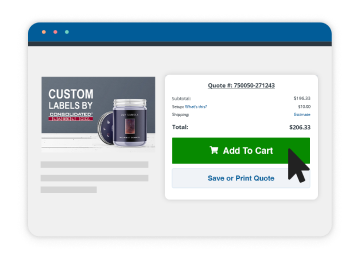 Printing household cleaning labels isn’t much different than printing any other product label except for the fact that it needs to withstand certain conditions that other labels aren’t likely to encounter. Cleaning products often have contents that are made with chemicals and dyes which can lessen a label’s quality if exposed. Selecting the right materials for household cleaning labels is key for successful, long-lasting labels. The following information is meant to help you get a better idea of what material types are best suited for household cleaning label applications so your labels are less likely to fade, smudge or yellow over the product’s lifespan.
Printing household cleaning labels isn’t much different than printing any other product label except for the fact that it needs to withstand certain conditions that other labels aren’t likely to encounter. Cleaning products often have contents that are made with chemicals and dyes which can lessen a label’s quality if exposed. Selecting the right materials for household cleaning labels is key for successful, long-lasting labels. The following information is meant to help you get a better idea of what material types are best suited for household cleaning label applications so your labels are less likely to fade, smudge or yellow over the product’s lifespan.
Selecting Materials for Household Cleaning Labels
Household cleaning labels typically consist of multiple layers of materials such as an adhesive, face stock, ink (i.e. printed image) and finish. We often print household cleaning labels on paper and film depending on the customer’s label application, budget, design and container. Since cleaning products often have liquid contents, we suggest you use fade resistance inks instead of water-based inks so the printed image isn’t likely to rub off. The right finish can further extend the label’s quality even in the chance that it’s exposed to chemicals, abrasion or moisture.
Use a Finish for Added Protection
In our How to Select a Finish for Your Labels article, we discuss what finishes are used for custom labels and why a particular finish would be used over another. Laminates and varnishes are types of finishes that are often applied to labels to protect the artwork, create a visual effect or prolong the label’s quality. Below is an overview of laminates and varnishes to help you understand why having a finish is important for household cleaning labels.
- Laminates: Made from film, laminates can be applied to paper and film face stocks to guard against chemicals, moisture, friction and other deteriorating forces. Laminates come in several varieties such as glossy, matte or outdoor polyester so it’s able to work with different label applications. It’s important to note that the face stock you choose can improve the cleaning label’s exposure to chemicals. Paper tends to cost less than film but doesn’t offer the same durability that film does, even if a laminate is applied to it. That’s because, over time, liquids, chemicals, and other substances can penetrate the face stock and laminate layers and cause damage.
- Varnishes: Unlike laminates, varnishes are liquids that are coated onto parts or the whole label then cured with a UV lamp during the printing process. Varnishes also come in several varieties like glossy, matte, and spot UV coating to suit almost any label style. Although varnishes add some protection to label artwork, it’s not as durable as laminates in conditions where it’s exposed to chemicals, moisture, friction, condensation, etc. because the varnish can wear off over time. Varnishes are great if you want to create an interesting visual effect with your label while offering it an extra measure of protection but it’s better suited for indoor applications that don’t face tough environments.
It can be challenging for those outside of our industry to understand why certain materials work better for household cleaning labels than others, but we hope you now have a clearer idea of the things that are considered to make high quality cleaning labels. Taking the time to examine all of your product’s qualities (container, main environment and contents) can make it easier for your customer service rep to offer guidance and advice on what will work best for your household cleaning labels. Chemical exposure, moisture, and product handling are just some of the factors that we take into account during the materials selection process to better ensure a successful label application.


